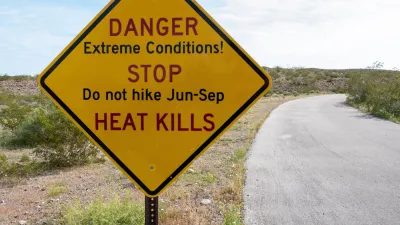Two federal agencies launched a new, easy-to-use, color-coded heat warning system that combines meteorological and medical risk factors.

The National Weather Service and Centers for Disease Control and Prevention launched a new online heat risk system called the Heat Risk Dashboard, according to an Associated Press article in the Portland Press Herald. The new tool provides a simplified seven-day forecast that uses a color-coded rating system to indicate when temperatures could be a health risk.
Moving forward, magenta will signal the deadliest of the five heat threat categories, indicating rare, long-duration extreme heat with little to no overnight relief, while red will indicate temperatures that fall within the top 5 percent hottest for a specific date and location. Then comes orange (moderate risk), yellow (minor risk, mostly to the very young, old, sick, and pregnant), and green (little to no risk).
The move to a new rating system comes as extreme heat events become more frequent and intense because of climate change. According to a CDC press release, more than two-thirds of Americans were under heat alerts in 2023, and rates of emergency department visits for heat-related illness reached peak levels across several U.S. regions compared to previous years.
The tool was designed to be simple and easy for the public and medical practitioners to use. It could also be a valuable tool for local planners and other city departments when preparing for extreme heat events, which present a major public health threat that disproportionately impacts vulnerable populations and low-income communities, and communicating emergency response plans to community members.
FULL STORY: When red-hot isn’t enough: New government heat risk tool sets magenta as most dangerous level

Planetizen Federal Action Tracker
A weekly monitor of how Trump’s orders and actions are impacting planners and planning in America.

Congressman Proposes Bill to Rename DC Metro “Trump Train”
The Make Autorail Great Again Act would withhold federal funding to the system until the Washington Metropolitan Area Transit Authority (WMATA), rebrands as the Washington Metropolitan Authority for Greater Access (WMAGA).

The Simple Legislative Tool Transforming Vacant Downtowns
In California, Michigan and Georgia, an easy win is bringing dollars — and delight — back to city centers.

The States Losing Rural Delivery Rooms at an Alarming Pace
In some states, as few as 9% of rural hospitals still deliver babies. As a result, rising pre-term births, no adequate pre-term care and "harrowing" close calls are a growing reality.

The Small South Asian Republic Going all in on EVs
Thanks to one simple policy change less than five years ago, 65% of new cars in this Himalayan country are now electric.

DC Backpedals on Bike Lane Protection, Swaps Barriers for Paint
Citing aesthetic concerns, the city is removing the concrete barriers and flexposts that once separated Arizona Avenue cyclists from motor vehicles.
Urban Design for Planners 1: Software Tools
This six-course series explores essential urban design concepts using open source software and equips planners with the tools they need to participate fully in the urban design process.
Planning for Universal Design
Learn the tools for implementing Universal Design in planning regulations.
Smith Gee Studio
City of Charlotte
City of Camden Redevelopment Agency
City of Astoria
Transportation Research & Education Center (TREC) at Portland State University
US High Speed Rail Association
City of Camden Redevelopment Agency
Municipality of Princeton (NJ)





























